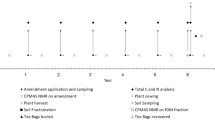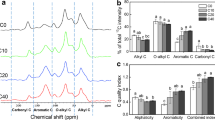Summary
Levels of aromatic and aliphatic acids in both Calluna and spruce soils followed a seasonal pattern with maximum levels of both classes of compound being found in summer months. Fatty acid yields were generally higher than those of the aromatics and were particularly high in the Calluna Ah horizon where they reached 6 mg/100 g soil (≡0.14 mM) in May and June. Of the individual acids o-hydroxybenzoic (salicylic) and benzoic acid were the most important aromatics each reaching levels around 1 mg/100 g soil (≡ approximately 0.03 mM) in Calluna soil, and 8-hydroxydecanoic (capric) yielding up to 3 mg/100 g (≡0.07 mM) in this soil in May, was the highest yielding aliphatic constiuent. Nonanoic acid yields of up to 0.76 mg (≡0.02 mM) were recorded. Collective and individual levels of both classes of compound in summer were higher than those which have previously been shown in seedling bioassays to produce considerable phytotoxicity. Fungitoxicity would also be expected at these levels of nonanoic acid. It is considered likely that these compounds are produced by microbial degradation of ericaceous plant residues which are rich in phenols and lipids and that summer peak levels arise because temperature and redox conditions are favourable for microbial activity at this time. The ecological significance of these observations is discussed.
Similar content being viewed by others
References
Ashton D H and Willis E J 1982 Antagonisms in the regeneration ofEucalyptus regnans in the mature forest.In The Plant Community as a Working Mechanism. Ed. E I Newman. pp 113–128. British Ecological Society Special Publications No. 1 Blackwell, Oxford.
Chou C H and Muller C H 1972 Allelopathic mechanisms ofArctostaphylos glandulosa var.zacaensis. Am. Midl. Nat. 88, 324–347.
Franke W and Schillinger A 1944 Zum Stoffwechsel der saurefesten Bacterien. Biochem. Z. 316, 313–334.
Glass A D M 1976 The allelopathic potential of phenolic acids associated with the rhizosphere ofPteridium aquilinum. Can. J. Bot. 54, 2440–2444.
Grubb P J, Green H E and Merrifield R C J 1969 The ecology of chalk heath: its relevance to the calcicole-calcifuge and soil acidification problems. J. Ecol. 57, 175–212.
Handley W R C 1963 Mycorrhizal associations and Calluna heathland afforestation. For. Comm. Bull. 23. HMSO, London.
Jalal M A F, Read D J and Haslam E 1982 Phenolic composition and its seasonal variation inCalluna vulgaris. Phytochemistry 21, 1397–1401.
Jalal M A F and Read D J 1983 The organic acid composition of Calluna heathland soil with special reference to phyto- and fungitoxicity. I. Isolation and identification of organic acids. Plant and Soil 70, 255–270.
Kiesel A 1913 Recherches sur l'action de divers acides et sels acides sur le development del'Aspergillus niger. Ann. Past. Inst. 27, 391–420.
Lewis H L and Johnson G T 1966 Intermediates of fatty acid metabolism byCunninghamella echinulata. Mycologia 58, 136–147.
Lynch J M 1980 Effects of organic acids on the germination of seeds and growth of seedlings. Plant Cell Environ, 3, 255–259.
Markley K 1960 Fatty Acids Part 1. Interscience, New York.
Pedersen T 1970 Effects of fatty acids and methyl octanoate on resting mycelium ofBoletus variegatus. Physiol. Plant. 23, 654–666.
Prill E A, Barton L V and Solt M L 1949 Effects of some organic acids on the growth of wheat roots in solutions. Contributions of the Boyce Thompson Institute 15, 429–435.
Read D J, Armstrong W and Weatherall J 1973 The effects of cultivation treatment on water potential and soil aeration in wet heathland with special reference to afforestation. J. Appl. Ecol. 10, 479–487.
Robinson R K 1971 Importance of soil toxicity in relation to the stability of plant communities.In The Scientific Management of Animal and Plant Communities for Conservation. Eds. E Duffey and A S Watt. pp 105–113.
Robinson R K 1972 The production by roots ofCalluna vulgaris of a factor inhibitory to the growth of some mycorrhizal fungi. J. Ecol. 60, 219–224.
Roff W J 1964 An analysis of competition betweenCalluna vulgaris andFestuca ovina. Unpublished Ph. D. thesis, University of Cambridge.
Sparling, G P, Ord B G and Vaughan D 1981 Changes in microbiol biomass and activity in soils amended with phenolic acids. Soil Biol. Biochem. 13, 455–460.
Stephenson F J 1982 Humus Chemistry. John Wiley, New York.
Thornton R H 1956 Fungi occurring in mixed oakwood and heath soil profiles. Trans. Br. Mycol. Soc. 39, 485–494.
Takijima Y 1964 Studies on organic acids in paddy fields soils with reference to their inhibitory effects on the growth of rice plants. Soil Sci. Plant Nutr. Tokyo 10, 14–21.
Tschager A, Hilscher H, Franz S, Kull U and Larcher W 1982 Jahreszeitliche Dynamik der Fettspeicherung vonLoiseleuria procumbens und anderen Ericaceen der alpinen Zwergstrauchheide Acta Oecol 3, 119–134.
Wang T S C, Yang T and Chung T 1967 Soil phenolic acids as plant growth inhibitors. Soil Sci. 103, 239–246.
Whitehead D C 1964 Identification of p-hydroxybenzoic, vanillic, p-coumaric and ferulic acids in soils. Nature London 202, 417.
Wyss O, Ludwig J and Joiner R 1945 The fungistatic and fungicidal action of fatty acids and related compounds. Arch. Biochem. 7, 415–425.
Author information
Authors and Affiliations
Rights and permissions
About this article
Cite this article
Jalal, M.A.F., Read, D.J. The organic acid composition of Calluna heathland soil with special reference to phyto- and fungitoxicity. Plant Soil 70, 273–286 (1983). https://doi.org/10.1007/BF02374786
Received:
Revised:
Issue Date:
DOI: https://doi.org/10.1007/BF02374786




